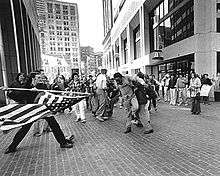The Soiling of Old Glory

The Soiling of Old Glory is a Pulitzer Prize–winning photograph taken for the Boston Herald American in 1976 by Stanley Forman.[1]
The photograph depicts a white teenager, Joseph Rakes, assaulting a black man, lawyer and civil rights activist Ted Landsmark, with a flagpole bearing the American flag as Landsmark was on his way to a meeting in the courthouse. Landsmark was active in trying to get more minority contractors in the construction industry, but he hadn't been paying attention to the busing protests. [2] According to Landsmark, "I had difficulty finding a parking space in downtown Boston, and I was running a few minutes late for the meeting in city hall. So I was in a hurry and perhaps not paying as much attention as I might have as I approached a corner, where the young demonstrators were coming in the other direction. I did not see them until both they and I were at that corner." [3]
It was taken in Boston on April 5, 1976, during one in a series of protests against court-ordered desegregation busing.[1] It ran on the front page of the Herald American the next day, and also appeared in several newspapers across the country.[1] It won the 1977 Pulitzer Prize for Spot Photography.[4]
Rakes was swinging the flag and trying to hit him, not trying to spear him as it appears in the photo, and he narrowly missed. Landsmark was bloodied during the incident.[5] An examination of all the photographs in the roll Forman shot reveals that Rakes missed Landsmark with the flag. Although anti-busing activist Jim Kelly appears to pin Landsmark's arms behind him, he is actually helping Landsmark to his feet. Kelly later positions himself between Landsmark and the other protestors to protect the lawyer. Landsmark had already been knocked to the ground, losing his glasses and suffering a broken nose, by the time he got up the famous picture was taken.[6]
Rakes was convicted of assault with a deadly weapon and sentenced to two years imprisonment and two years probation. The jail sentence was suspended. In 1983 the Boston police issued a warrant alleging that Rakes had beaten to death the brother of his girlfriend.[7] He fled prosecution, but returned in 1988 after the murder charge was dropped.[8] Rakes carried the stigma of being known as "the flag kid", but eventually turned his life around, getting married and having a family while laboring as a construction worker and later in hazardous waste.[6]
References
- 1 2 3 Masur, Louis P. (2008-04-10). "The Soiling of Old Glory". Slate. Retrieved 2008-04-12.
- ↑ "Life After Iconic Photo: Today's Parallels Of American Flag's Role In Racial Protest". NPR. Retrieved 2016-09-18.
- ↑ "Life After Iconic Photo: Today's Parallels Of American Flag's Role In Racial Protest". NPR. Retrieved 2016-09-18.
- ↑ "The Pulitzer Prize Winners, 1977". The Pulitzer Prizes. Retrieved 2008-04-12.
- ↑ "Stars and Strife". Retrieved 2011-06-17.
- 1 2 Bayard, Louis (28 April 2008). "Flagging America's racial divide". Salon. Retrieved 16 May 2014.
- ↑ "Boston Man Sought on Murder Warrant". The Day (New London, CT). 1 February 1983.
- ↑ Ralph, James. "The picture of hatred". Chicago Tribune. Retrieved 3 Dec 2016.
Further reading
- Louis P. Masur (2008). The Soiling of Old Glory: The Story of a Photograph That Shocked America. Bloomsbury Press.